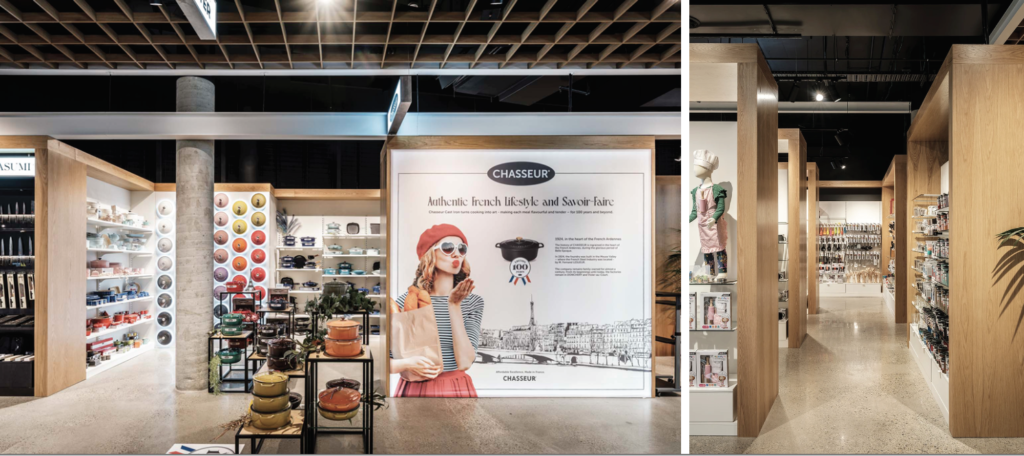Designer Spotlight — McCartney Design

In our eighth Designer Spotlight interview, we spoke to Gary McCartney, Founder of McCartney Design. Continue reading to learn more about Gary’s career, his strategic approach to design, and his predictions for retail spaces.
U. How did you get into design?
G. I originally qualified as an architect in the UK. One of my first jobs was doing refurbs of pubs for Bass Yorkshire. The experience with interiors led me into retail design and I’ve been doing that in different countries ever since.
U. You have a diverse portfolio of commercial projects, what is your favourite sector to work in?
G. We specialise in retail and hospitality and retail is the one I’m personally closest to, although some of my team members would probably go for hospitality.
U. What is your favourite project you’ve done to date?
G. They are all favourites for different reasons. Sometimes it’s the size of the project, sometimes it’s a favourite idea or strategy, sometimes it’s about achieving something on a budget. My latest favourite is a showroom for homewares wholesaler Sheldon and Hammond – 1,000 SQM and 60 brands. It was a challenging project, and we did it during lockdown. I like the fact that we managed to make sixty brands work together within an overall framework and still make it very much a Sheldon and Hammond space.

Sheldon & Hammond | Asquith, Sydney
U. What is your design process and does it change much depending on the project?
G. We’re always strategy first, design second. Our discovery and direction stages are vital as they inform the rest of the design, documentation and delivery stages. There are set milestones and sign-off points. We tailor it to each client and their needs, but the process doesn’t change – it’s very structured but we find it works very well for clients and ourselves.
U. How would you describe your design style?
G. There isn’t one. Each project comes from the brief and the strategy. Maybe that’s a style. We try to avoid particular trends and colours and stay off Pinterest as much as possible. What we have learned to do is get the maximum value from a budget – there’s never anything there that doesn’t need to be. That might be a style as well!
U. What are your tips for collaborating with clients to create the best possible space?
G. Trust and mutual respect are important from the start. We encourage our clients to open up to us about what their real needs and goals are right from the start. Communication is key at all points. We structure our process so that clients have the opportunity to provide clear and forthright feedback at each stage. We’re not afraid of feedback and we listen.

Barbeques Galore Flagship | Everton Park, Brisbane
U. What do you love most about design?
G. For me it’s a continuous learning process. To create a commercial environment like a shop you need to very quickly learn about someone else’s business, the category they are in and their customers. Even though most of what we do is retail, that’s different every time. Customer behaviour is particularly interesting, and I enjoy delving into the psychology of why people do what they do.
U. What advice would you give to someone entering the interior design business?
G. Most people enter the design business as interns or junior designers. My advice would be to listen a lot, be proactive and put the hours in. Don’t be afraid to put forward ideas but don’t be disappointed if they don’t all stick. We have team members who started out as juniors and are now senior designers – that’s how they got there.
U. What are your upcoming trends predictions?
G. I really wish I could see into the future. It would make business a lot more predictable. If there’s one pretty obvious trend it’s around customers’ expectations of bricks and mortar stores. They are definitely increasing. Customers expect to enter another world- a place that’s immersive and where you’ll willingly spend time. Even convenience stores should rise above the functional and inject brighter moments into people’s days. Another trend might be a rethinking of traditional leasing agreements, with an impact on how long a store fit out has to last and what goes into it from a sustainability point of view. Building in adaptability is a lot less wasteful of resources than gutting and rebuilding on a five-year cycle.

Great Dane | Fitzroy, Melbourne
Quick Fire Questions:
U. Working digitally or on paper?
G. I enjoy both.
U. Early bird or night owl?
G. Depends what’s on.
U. Favourite project?
G. Great Dane, Fitzroy – it was one of the ones that kicked the business off in 2011 and a nice simple idea.
U. Guilty pleasure?
G. Spread sheets.
U. Best and worst interior design trends?
G. Best: Lighting design just keeps getting better. Worst: Of-the-moment colour schemes. They get old a minute later.
U. You’re hosting your dream dinner party, who are your three guests?
G. My wife and two daughters – we are in different countries and don’t get the chance much these days.
U. What’s next for McCartney Design?
G. We are actively looking for more international work to add to our Australian portfolio. We already work for international brands and are active in India, China and the UK. There’s a whole world of opportunity out there.
Learn more about McCartney Design here.
Whether you’re a designer interested in being featured in Designer Spotlight or a looking for innovative design and fit-out solutions to level up your business, we’d love to hear from you. Get in touch here.


































